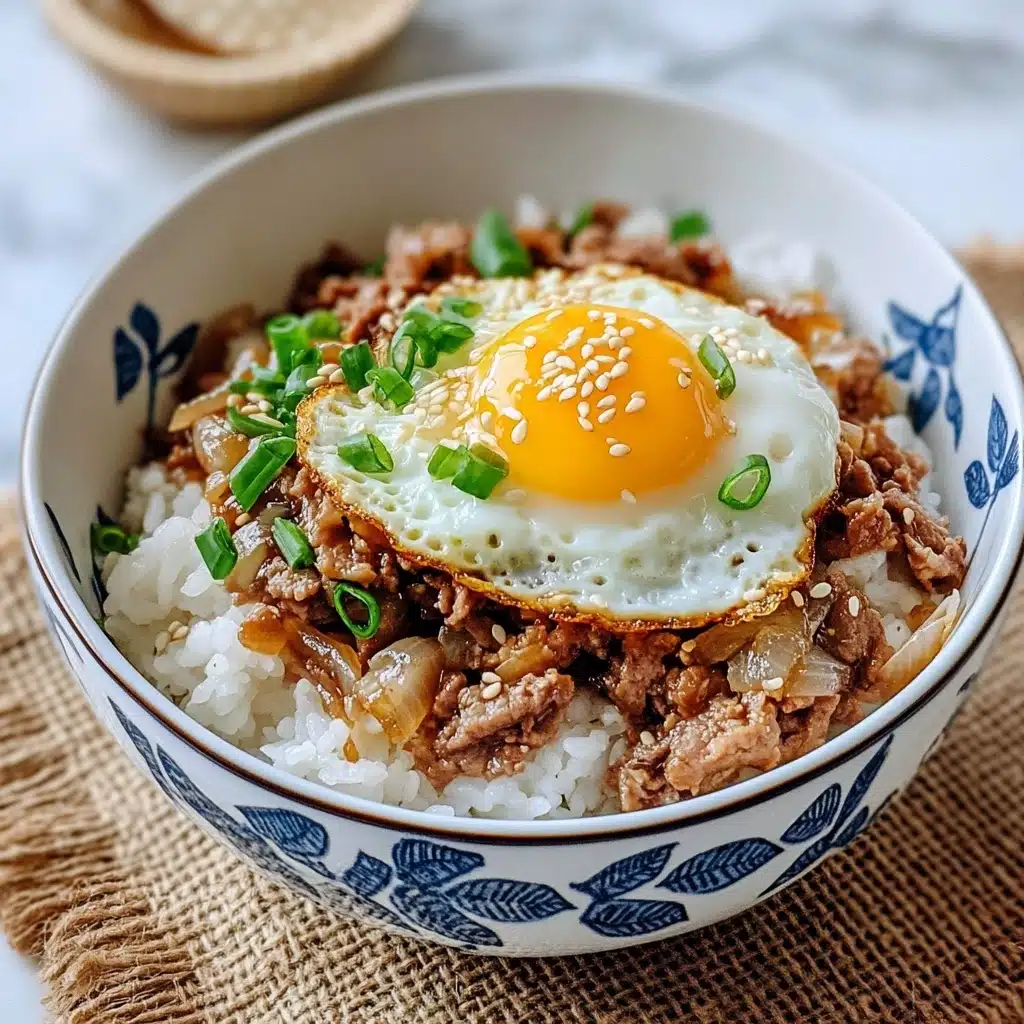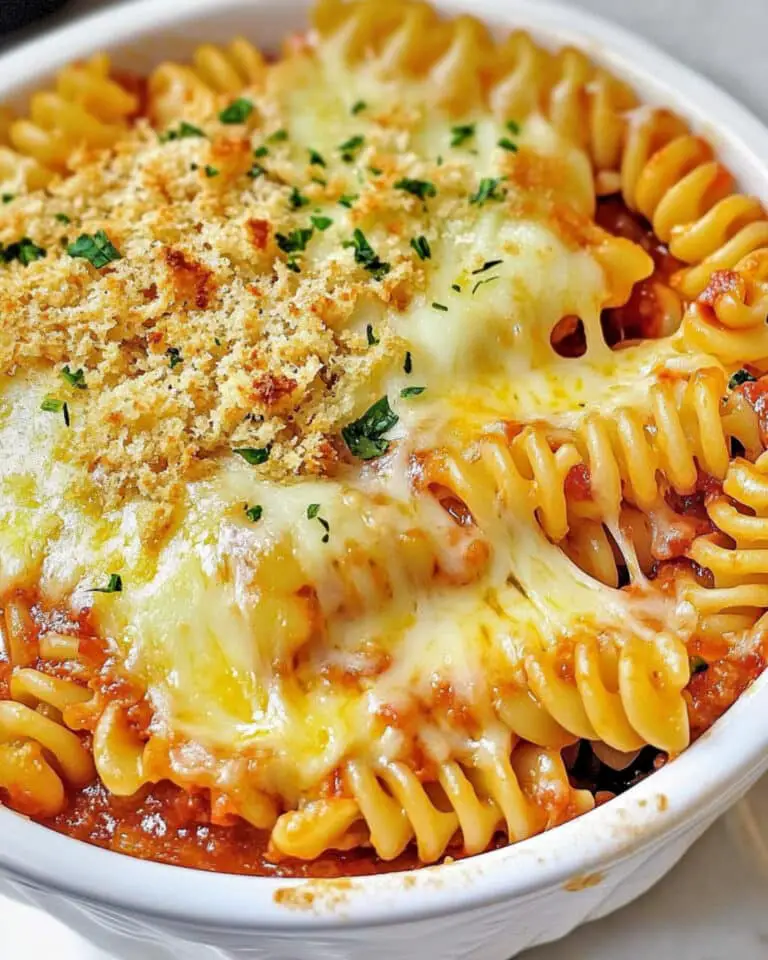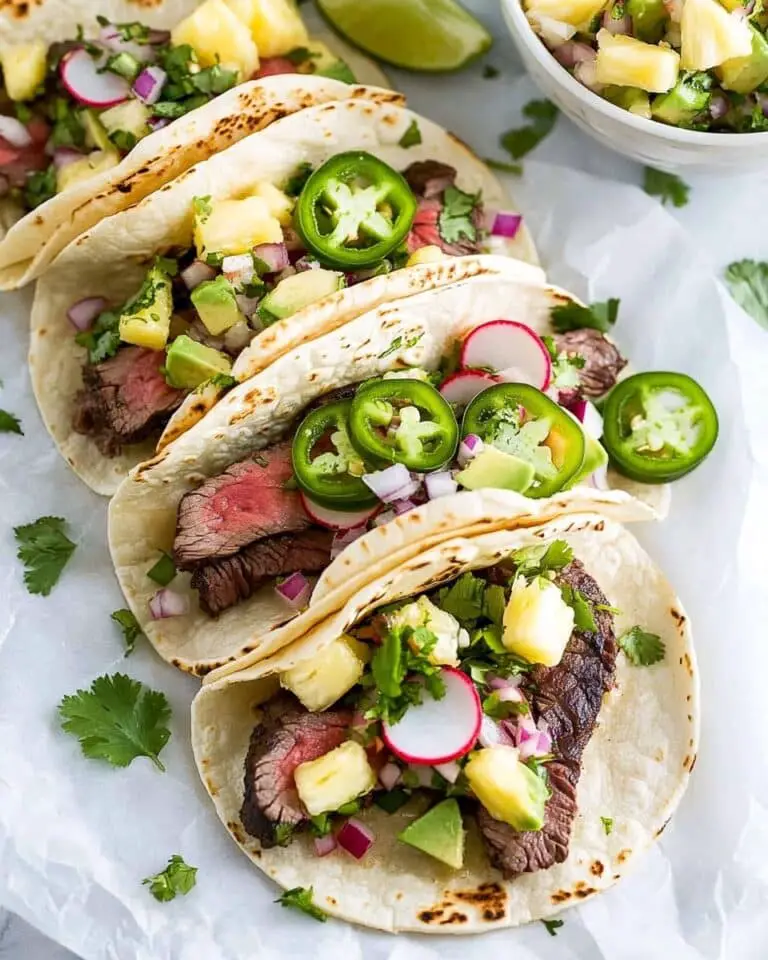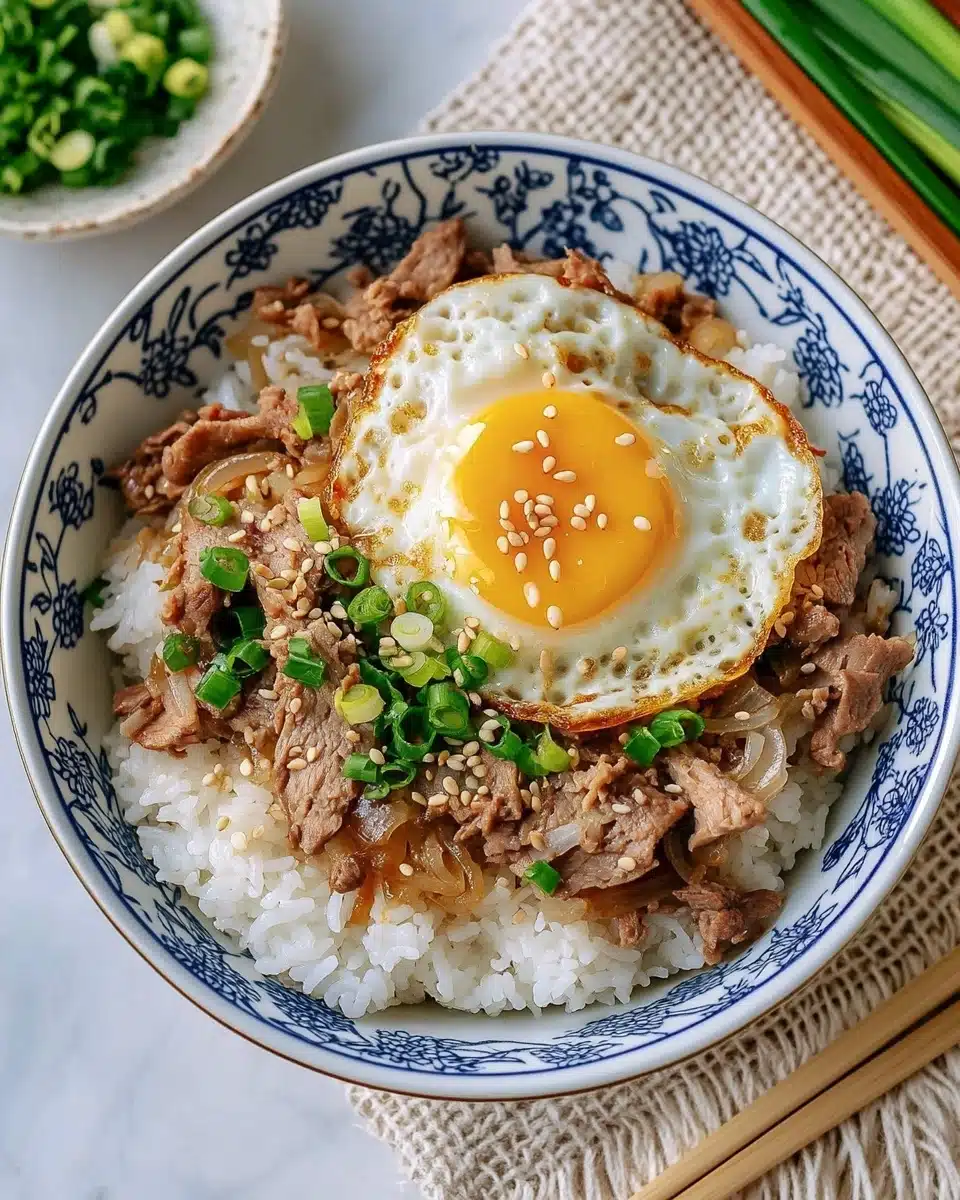
Gyudon (Japanese Beef & Rice Bowl) Recipe is one of those comforting dishes that hits all the right notes—savory, slightly sweet, and brilliantly simple. I remember the first time I made it; the aroma of simmering onions and tender beef mixed with soy and mirin instantly transported me to a cozy little eatery in Tokyo. It’s a perfect weeknight meal because it comes together quickly, yet feels like a real treat.
What makes this Gyudon (Japanese Beef & Rice Bowl) Recipe so special is its balance of rich flavors against fluffy rice and a runny egg yolk that ties it all together beautifully. You’ll find that this dish is not just delicious but also versatile enough to customize with your favorite garnishes. Once you give this recipe a try, I bet it’ll become one of your go-to comfort foods too!
Why You’ll Love This Recipe
- Quick and Easy: From sliced onions to tender beef, it comes together in about 40 minutes, perfect for busy nights.
- Authentic Japanese Flavor: The combination of mirin, soy sauce, and dashi stock makes the taste truly satisfying and authentic.
- Customizable and Comforting: You can adjust toppings and even pick your favorite cut of beef for a personal touch.
- Family Favorite: My own family goes crazy for this dish, making it a staple in our home cooking rotation.
Ingredients You’ll Need
Choosing fresh, thinly sliced beef is key here, and the other ingredients blend to create that savory-sweet broth this Gyudon (Japanese Beef & Rice Bowl) Recipe is known for. If you can find dashi stock, it adds a wonderful umami base, but chicken or beef broth will also work.
- Neutral oil: I usually go for vegetable or canola oil because of their subtle flavor and high smoke point.
- Onions: Thinly sliced onions cook down nicely and become deliciously sweet.
- Beef: Very thinly sliced fatty chuck or ribeye is best—its marbling keeps the meat tender.
- Sugar: Just a little helps balance out the savory soy and tangy mirin.
- Mirin: This sweet rice wine adds a distinct, pleasant flavor—don’t skip it if you want authenticity!
- Soy sauce: Use a good-quality soy sauce for depth and saltiness.
- Dashi stock: Traditional Japanese broth that enriches the sauce, but chicken or beef broth are fine alternatives.
- Eggs: Cooked sunny-side up to add richness and creaminess with that runny yolk.
- Cooked white rice: Short or medium grain is classic for this dish, giving you that perfect sticky base.
- Scallion: Adds freshness and a slight bite when sprinkled on top.
- Toasted sesame seeds (optional): A little nutty crunch that really elevates the final bowl.
Variations
I love playing around with this Gyudon (Japanese Beef & Rice Bowl) Recipe to keep things interesting. You can easily make it lighter or heartier depending on what you’re craving or what you have on hand.
- Vegetarian Version: I once swapped beef for sliced mushrooms and added extra soy sauce and mirin to keep that deep umami flavor—you won’t miss the meat!
- Spicy Kick: Adding a little shichimi togarashi or a drizzle of chili oil after cooking gives the dish a nice heat that really wakes up the flavors.
- Rice Alternatives: Feel free to swap white rice for brown rice or quinoa for a healthier twist, though the classic sticky rice has that perfect texture.
- Egg Preparation: If you’re not an egg yolk fan, a soft-boiled egg or even a poached egg works beautifully as well.
How to Make Gyudon (Japanese Beef & Rice Bowl) Recipe
Step 1: Gently Caramelize the Onions
Start by heating your neutral oil in a large skillet over medium-high heat. Add the thinly sliced onions and stir frequently for about 10 minutes. You want the onions to soften and develop a gentle sweetness without burning. Taking your time here really pays off because these caramelized onions form the flavorful base of the dish.
Step 2: Brown the Beef and Add Seasonings
Next, add the thinly sliced beef and sugar to the onions. Stir often until the beef just starts to brown—don’t overcook it here because it will keep cooking in the sauce. Then pour in mirin, soy sauce, and the dashi stock. Bring everything to a gentle simmer and let it cook uncovered for 10-15 minutes, allowing the sauce to reduce and thicken slightly. Be sure to taste the broth and adjust soy sauce as needed for your preferred saltiness.
Step 3: Perfect Your Sunny-Side Up Eggs
While the beef simmers, heat a couple tablespoons of oil in another skillet—cast iron works wonderfully here. Cook the eggs sunny-side up, aiming to keep the yolks runny; this adds incredible creaminess to the dish when served. If your skillet isn’t big enough, cook the eggs in batches. Remember, don’t flip the eggs; you want those beautiful golden yolks on top.
Step 4: Assemble and Garnish
To serve, scoop freshly cooked white rice into bowls. Ladle the tender beef and onion mixture generously over the rice, then top each bowl with a sunny-side up egg. Finish with chopped scallions and a sprinkle of toasted sesame seeds if you like that extra nutty crunch. Dive in right away while it’s hot!
Pro Tips for Making Gyudon (Japanese Beef & Rice Bowl) Recipe
- Buy Very Thinly Sliced Beef: Slicing it thinner than usual helps the beef cook quickly and stay tender – I get mine from the Asian market.
- Don’t Rush the Onions: Slowly cooking them until soft, not browned black, creates that signature sweetness that makes the sauce amazing.
- Keep Egg Yolks Runny: The rich yolk blends into the beef and rice, giving each bite a creamy, luscious texture.
- Taste and Adjust: Always taste your sauce before serving—if it’s too salty, add a splash of water or stock; if bland, a little more soy or sugar can brighten it up.
How to Serve Gyudon (Japanese Beef & Rice Bowl) Recipe
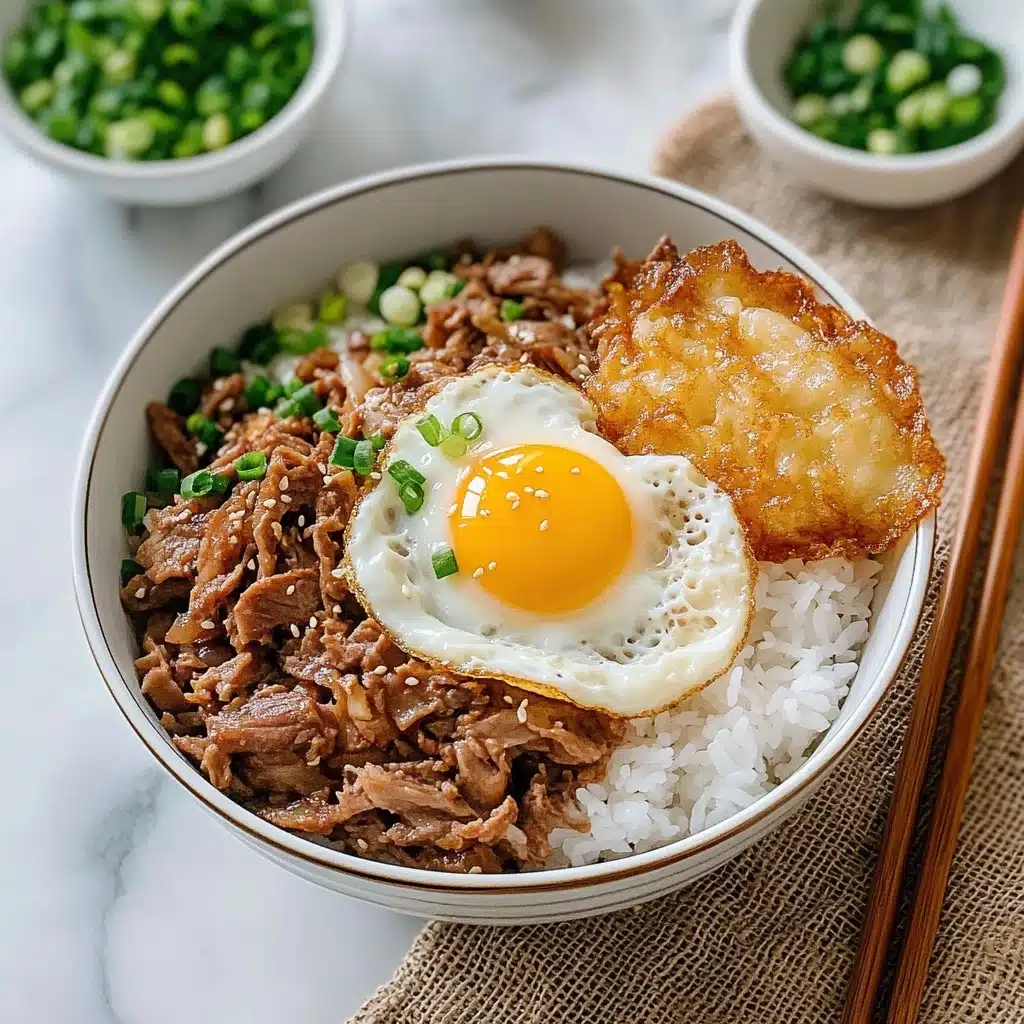
Garnishes
My go-to garnishes include freshly chopped scallions for a light onion kick and toasted sesame seeds for a subtle nutty crunch. Sometimes, I like to add a sprinkle of shichimi togarashi for a little heat or some pickled ginger on the side to brighten every bite.
Side Dishes
I usually serve Gyudon alongside a simple miso soup and a crunchy cucumber salad for textural contrast. Pickled daikon or a side of steamed greens also rounds out the meal nicely, keeping things light and refreshing.
Creative Ways to Present
For special occasions, I like to serve Gyudon in individual donburi bowls layered with thinly sliced nori or shiso leaves for an elegant look. Another fun idea is to present it as a donburi bento box, with compartments for rice, beef, egg, and crisp pickled veggies—it’s a feast for the eyes and the palate!
Make Ahead and Storage
Storing Leftovers
After cooking, let the beef cool to room temperature, then store it separately in an airtight container with the sauce in the fridge. I keep cooked rice in its own container as separating these helps preserve texture and flavor for leftovers.
Freezing
I’ve frozen leftover beef and sauce before with good results—just make sure to cool it completely before freezing in a freezer-safe container. The rice and eggs don’t freeze well, so I recommend freezing only the beef portion if you want to meal prep.
Reheating
To reheat, warm the beef and sauce gently in a skillet or microwave to avoid overcooking. For the rice, sprinkle a little water before microwaving to help keep it moist. I usually pan-fry a fresh egg or reheat a soft-boiled one to top the bowl when serving leftovers.
FAQs
-
What kind of beef is best for Gyudon?
Very thinly sliced fatty beef such as chuck or ribeye works best for Gyudon because it cooks quickly and stays tender and juicy. You can find pre-sliced beef specifically for Gyudon at many Asian grocery stores, or ask your butcher to slice it thinly.
-
Can I use regular broth instead of dashi stock?
Absolutely! While dashi adds traditional umami flavor, substituting beef or chicken broth works fine and still gives you a delicious and savory sauce. Just adjust seasonings to taste since broths can vary in saltiness.
-
How do I get perfect runny yolks on the eggs?
Cook the eggs sunny-side up on medium-low heat without flipping them. Covering the skillet for a minute or so helps cook whites through without hardening the yolk. Timing is everything—about 3-4 minutes usually does the trick.
-
Is this recipe suitable for meal prepping?
Yes! Prepare the beef and sauce ahead of time, store separately from rice and eggs, and assemble quickly when you’re ready to eat. Freeze the beef and sauce only for longer storage to maintain freshness.
Final Thoughts
Gyudon (Japanese Beef & Rice Bowl) Recipe holds a special place in my heart because it’s both an everyday comfort and a doorway into Japanese home cooking. I encourage you to give it a try—once you taste that tender beef bathed in a sweet-savory sauce, topped with a silky yolk, you’ll understand why it’s such a beloved dish. It’s simple, satisfying, and perfect to share with friends or family any day of the week.
Print
Gyudon (Japanese Beef & Rice Bowl) Recipe
- Prep Time: 10 minutes
- Cook Time: 30 minutes
- Total Time: 40 minutes
- Yield: 4 servings
- Category: Main Course
- Method: Stovetop
- Cuisine: Japanese
Description
Gyudon, a classic Japanese beef and rice bowl, features tender, thinly sliced beef simmered with onions in a savory-sweet soy and mirin sauce over steamed rice, topped with a perfectly cooked sunny-side-up egg and garnished with scallions and toasted sesame seeds. This comforting dish comes together quickly using simple ingredients and offers a delightful balance of flavors and textures.
Ingredients
Beef and Onion Mixture
- 2 tablespoons neutral oil (such as vegetable or canola oil)
- 2 medium onions, very thinly sliced
- 1 pound very thinly sliced beef (fatty beef chuck or ribeye)
- 2 teaspoons sugar
- 2 tablespoons mirin
- 2 tablespoons soy sauce
- 1 cup dashi stock (or substitute beef or chicken stock)
Eggs and Garnishes
- 4 eggs
- 4 cups cooked white rice (short grain or medium grain preferred)
- 1 scallion, chopped
- 2 teaspoons toasted sesame seeds (optional)
Instructions
- Cook the Onions: Heat neutral oil in a large skillet over medium-high heat. Add the thinly sliced onions and cook for about 10 minutes, stirring often, until softened and lightly caramelized.
- Brown the Beef and Simmer: Add the thinly sliced beef and sugar to the skillet with the onions. Cook until the beef is slightly browned. Pour in mirin, soy sauce, and dashi stock, then bring to a simmer. Cook for 10–15 minutes to reduce the stock into a thin flavorful sauce. Taste and adjust seasoning with additional soy sauce if needed.
- Prepare the Eggs: While the beef simmers, heat a couple tablespoons of oil in a cast iron or non-stick skillet over medium heat. Cook the eggs sunny-side up, making sure the yolks remain runny. Cook in batches if necessary.
- Assemble the Bowls: Divide the cooked rice evenly among four serving bowls. Top each bowl with the simmered beef and onion mixture, then place one sunny-side-up egg on top.
- Garnish and Serve: Sprinkle chopped scallions and toasted sesame seeds, if using, over each bowl before serving. Enjoy immediately for best flavor and texture.
Notes
- Use very thinly sliced beef for quick cooking and tender texture; fatty cuts like chuck or ribeye work best.
- Dashi stock gives authentic umami flavor, but beef or chicken stock are good substitutes.
- Maintain runny yolks on the eggs for authentic Gyudon experience—this adds richness to the dish.
- To make it gluten-free, use gluten-free soy sauce.
- Leftovers can be stored refrigerated up to 2 days, but reheat gently to avoid drying out the beef.

